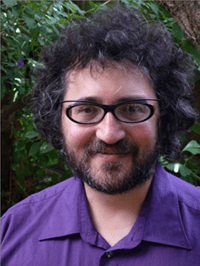In The Opposite of Work, this very lovely book of poems, Hugh Behm-Steinberg dares to address the themes of divinity in the world, explore everyday and abstract mysticism, and celebrate the body in poems that wash over the reader like healing waterfalls of grace. These pieces have a numinous quality reminiscent of Gerard Manley Hopkins. Indeed, in Hopkin’s memorable image of God in the world, they release the potent charge of Spirit “like shine from shook foil.”
In the title poem (which Behm-Steinberg presents well into the collection), the poet explores physical intimacy, the loss of self in communion with another, where, he says, “…I get to feel my body stop being my body.” Total immersion in the other is the opposite of work, the absence of effort, pure experience. He speaks here of finding “new variations on the theme of warmth” but also touches on more prosaic reality like “…getting to enjoy feeling my socks sag around my ankles” or “the sound of your insulin pump.”
Throughout the collection, Behm-Steinberg fearlessly plunges into deep themes. By early evoking Biblical stories of creation, he makes it absolutely clear that this is not a book of occasional poetry or casual reflections on daily life, but something more profound and mythic.
Biblical themes are confronted early and directly with titles like “Eden,” “Adam,” and “Sea Monsters.” Nevertheless, Behm-Steinberg is not afraid to draw upon every day commonplaces like the smoking of cigarettes or pot, while still being marvelously at ease using words like “God” or “divinity” without affectation.
In poem after poem, he delicately explores the effort to come to terms with one’s own soul and the Other, with memory and the mystery of one’s parents, with ghosts, with creation, with God.
One particularly effective poem is “For My Parents,” which begins with the amusing and seductive line, “In which I am forced to recognize my ghosts.” The ghosts, he writes, come with lawyers, demanding alimony. “We settle, are settling” and then, twice repeated, “No one is at fault. No one is at fault.” The poem goes on to explore an explosion of images such as a golden bowl of cherry blossoms, and “a toy I can’t play with anymore.” Without ever explicating historical specifics, the poem evokes a depth of family relationship, debt, memory and ambivalence far more effectively than many more easily accessible poems by others.
The poems are interesting to look at as well. Not written in conventional lines or stanzas, they are each shaped geometrically in unexpected formations with breaks created by spaces between short spurts of words on the same line, not necessarily by line breaks. The effect is to startle the eye into moving randomly about the poem, the way one might look at a painting. One can read the words in sequence, but one’s eye is likely to dart about from word to word in the poem creating a new sequence with each viewing, as if there were more poems within the poem, like an elegantly constructed puzzle box.
This remarkable technical construction draws the reader into the poems as if swimming in a river surrounded by darting fish, so that the poems are experienced as a kind of language immersion as much as the organized explication of ideas (although they will stand up to analysis and are full of meaningful content).
The experience of reading this remarkable text reminds me of a visit I once made to the remote village of Havasupai, at the bottom of the Grand Canyon. This tiny Indian village, continuously inhabited by the same tribe for many centuries, is accessible only by trudging eight miles down from the rim of the Canyon to its base. As one descends, one encounters an amazing series of waterfalls, pools of water and unexpected cascades around each bend in the path. For those of us living in the urban present, it is an almost spooky descent into another world, evoking a feeling of timelessness and the presence of ancient spirits and deep, nearly forgotten, sources of delight, to be rediscovered and embraced, if one is willing. Reading this book is like that.
Mary Behm-Steinberg’s fine illustrations add considerably to the overall effect. Her drawings, which appear opposite the text on every page, incorporate words from the poems, and the image of a child exploring a mysterious world of endlessly spiraling staircases and curious, evocative images from ravens to eggs. Most remarkably, Mary Behm-Steinberg has organized the child’s exploration into a flip book, meaning that by flipping rapidly through the pages, one can see the entire series of drawings as an animation of the child’s wanderings through the spiraling staircase with words emerging from objects and swirling about in endlessly interesting ways. It is an excellent compliment to the poems.
The Opposite of Work is a highly original collection, ambitious and admirable. Many of the poems are unusually memorable and all are absorbing.





